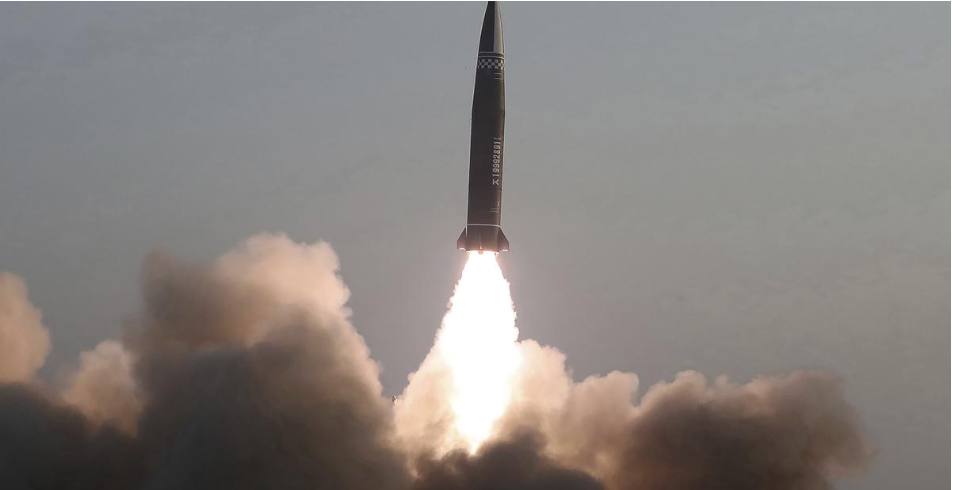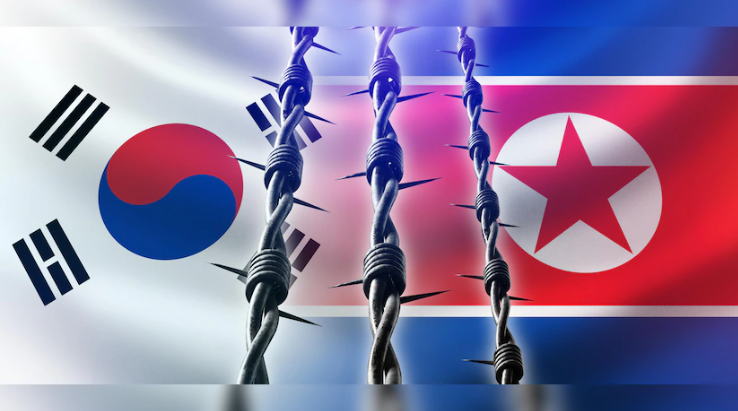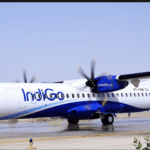North Korea Launches in an unsettling development that continues to stoke tensions in the Korean Peninsula, North Korea launched a projectile toward its eastern waters, according to reports from South Korea’s Joint Chiefs of Staff (JCS). This marks Pyongyang’s second missile test of the year, coming just days after an earlier launch in what appears to be a continued effort by the North to showcase its military capabilities amid growing regional and global concerns.
The projectile—likely a ballistic missile, according to preliminary analyses by South Korean and Japanese authorities—was fired early Tuesday morning, local time, into the East Sea (also known as the Sea of Japan). This latest missile test underscores North Korea’s defiance of United Nations resolutions banning ballistic missile activities and serves as a reminder of Pyongyang’s determination to bolster its weapons program in the face of intensified international sanctions and diplomatic efforts to curb its nuclear ambitions.
With tensions already high in Northeast Asia, the launch raises alarm for neighboring countries and the international community, underscoring the precarious balance of peace and security in the region. This article delves into the details of the missile launch, the potential motivations driving Pyongyang’s actions, and the broader implications for the Korean Peninsula and global stability.
Details of the Latest Launch
What Was Launched?
South Korea’s Joint Chiefs of Staff detected the projectile launch at approximately 7:20 AM local time. While the exact type and trajectory of the missile have yet to be confirmed, North Korea Launches early analyses suggest it was likely a short- to medium-range ballistic missile, a class of weapon that North Korea has frequently tested as part of its expanding arsenal.
Japanese Defense Minister Minoru Kihara stated that the projectile landed outside Japan’s exclusive economic zone (EEZ), which stretches 200 nautical miles from the country’s coast, North Korea Launches and that there were no immediate reports of damage to Japanese vessels or aircraft. Initial assessments indicate the missile traveled roughly 700 kilometers (435 miles) at a maximum altitude of approximately 50 kilometers (31 miles) before plunging into the sea.
If confirmed, this would mark Pyongyang’s second missile launch in 2025, with an earlier launch taking place just last week. That test involved what North Korea claimed to be a “super-large multiple rocket launcher,” which experts interpreted as a demonstration of its artillery capabilities rather than a strategic ballistic missile. However, this week’s launch appears to involve a more sophisticated and provocative technology.
South Korea’s Response
In response to the launch, South Korea’s military released a statement condemning the act as a violation of international law and an escalation of regional tensions. The JCS emphasized its commitment to closely monitoring the situation in collaboration with allied forces, including the United States, North Korea Launches while maintaining a heightened level of readiness.  For the more information click on this link
For the more information click on this link
South Korea’s National Security Council convened an emergency meeting shortly after the launch, North Korea Launches during which officials called for a “stern response” to North Korea’s continued weapons testing. In a press briefing, South Korea’s President, Yoon Suk Yeol, warned that Pyongyang’s provocations would only deepen its international isolation and urged the regime to return to denuclearization talks.
North Korea’s Motivations for Missile Launches
Pyongyang’s latest projectile test serves as part of a broader pattern of behavior, North Korea Launches wherein North Korea intensifies missile testing during times of geopolitical uncertainty. Analysts suggest multiple motivations behind this recent uptick in launches:
1. Demonstrating Military Capabilities
The missile launch comes as North Korean leader Kim Jong Un continues to push his ambitious military modernization agenda. Over the past few years, North Korea has rapidly expanded its weapons arsenal, including testing long-range missiles capable of delivering nuclear warheads, hypersonic missiles, North Korea Launches and submarine-launched ballistic missiles (SLBMs).
The launch allows North Korea to demonstrate the operational readiness of its missile systems and reinforce its deterrence posture against perceived threats from its neighbors and the United States.
2. Protest Against Joint Military Drills
The launch is believed to be a direct response to ongoing joint military drills between South Korea and the United States, which Pyongyang frequently denounces as “rehearsals for an invasion.” The two allies recently conducted large-scale air and naval exercises, which included the deployment of U.S. strategic assets, North Korea Launches such as B-52 bombers, to the Korean Peninsula.
In recent years, North Korea has used missile tests to signal its opposition to such drills and heighten pressure on Washington and Seoul to halt military exercises.
3. Bargaining for Sanctions Relief
North Korea’s economy, already battered by years of mismanagement and international sanctions over its nuclear weapons program, continues to face severe difficulties, North Korea Launches exacerbated by the global economic downturn and the effects of the COVID-19 pandemic. Experts argue that Pyongyang’s missile provocations are partly aimed at forcing the U.S. and its allies to reconsider sanctions in exchange for de-escalation.
Regional and International Reactions
South Korea and Japan’s Alarm
Both South Korea and Japan have consistently sounded the alarm over North Korea’s missile launches, North Korea Launches seeing them as a direct threat to regional stability and national security. South Korea has called for greater military readiness and bolstered its missile defense systems in response to the increasing frequency of North Korean missile tests. Similarly, Japan continues to work closely with U.S. forces, including deploying Aegis-class destroyers and anti-missile batteries to counter potential threats.
Japanese Prime Minister Fumio Kishida called the launch “outrageous” and reiterated Tokyo’s commitment to enhancing coordination with South Korea and the U.S. to address North Korea’s provocations.
United States Condemns North Korea’s Actions
The U.S. condemned the missile test as destabilizing and reiterated its “ironclad commitment” to the defense of its regional allies, South Korea and Japan. In a statement, the State Department said:
“North Korea’s continued weapons testing is a brazen violation of UN Security Council resolutions and poses a significant threat to peace and stability in the Indo-Pacific region.”
Pentagon officials also reaffirmed the U.S. military’s readiness to respond to any provocation, North Korea Launches emphasizing that joint military exercises would continue as planned.
China and Russia’s Response
While China and Russia have traditionally been reluctant to join the U.S.-led effort to sanction North Korea, they have occasionally voiced concerns over the destabilizing potential of Pyongyang’s weapons testing. However, in recent years, Beijing and Moscow have also criticized U.S. military presence in the region, framing it as a factor driving North Korea’s provocative actions. Both nations called for restraint on all sides, North Korea Launches urging a return to multilateral diplomatic efforts.
Broader Implications for the Korean Peninsula
1. Heightened Security Challenges
North Korea’s continued missile tests heighten the possibility of an arms race in Northeast Asia, as regional actors, including South Korea and Japan, ramp up their defense investments. South Korea, for example, is actively developing its own missile defense systems and long-range strike capabilities, North Korea Launches while Japan recently announced a record increase in its defense budget.
2. Stalemate in Denuclearization Talks
The launch highlights the continuing deadlock in denuclearization talks between the U.S. and North Korea. Despite multiple diplomatic attempts over the years—most notably the historic summits between former President Donald Trump and Kim Jong Un—no substantial progress has been made in dismantling Pyongyang’s nuclear program.
The Biden administration has expressed willingness to engage in dialogue without preconditions, North Korea Launches but North Korea insists that sanctions relief and security guarantees are prerequisites for negotiations.  For the more information click on this link
For the more information click on this link
3. Strain on U.S.-China Relations
As one of North Korea’s few remaining allies, China plays a significant role in influencing Pyongyang’s behavior. However, deteriorating relations between Washington and Beijing complicate efforts to secure Chinese cooperation in addressing the North Korean issue.
Conclusion: A Tense Outlook Ahead
North Korea’s second missile launch of the year further underscores the challenges of achieving peace and stability on the Korean Peninsula. As Pyongyang continues to develop and showcase its missile capabilities, regional and global players are left grappling with how to respond to a regime determined to advance its military ambitions.
While the United States and its allies remain committed to deterring aggression and protecting regional stability, the enduring deadlock in denuclearization negotiations and the rising frequency of missile launches suggest that tensions are unlikely to ease anytime soon. Without a renewed push for diplomacy—one that balances pressure with meaningful incentives—the Korean Peninsula risks sliding further into a cycle of escalation, North Korea Launches leaving the region and the world on edge. ALSO READ:- U.S. Optimistic About Gaza Deal: “It Can Get Done This Week” 2025






1 вин вход 1win6001.ru .
скачать мостбет официальный сайт http://mostbet6006.ru .
1вин https://familyclub.borda.ru/?1-6-0-00002163-000-0-0-1743051813/ .
motsbet motsbet .
официальный сайт 1 вин официальный сайт 1 вин .
1вин официальный сайт вход http://familyclub.borda.ru/?1-6-0-00002163-000-0-0-1743051813 .
1вин кг https://www.1win6001.ru .
1win ставки официальный сайт https://www.familyclub.borda.ru/?1-6-0-00002163-000-0-0-1743051813 .
1win личный кабинет balashiha.myqip.ru/?1-12-0-00000437-000-0-0-1743258848 .
1вин приложение https://www.alfatraders.borda.ru/?1-0-0-00004932-000-0-0-1743258210 .
1 win.pro 1 win.pro .
1 win pro https://www.1win6049.ru .
зайти в 1вин 1win6049.ru .
1вин войти https://www.balashiha.myqip.ru/?1-12-0-00000437-000-0-0-1743258848 .
1вин http://www.alfatraders.borda.ru/?1-0-0-00004932-000-0-0-1743258210 .
1win личный кабинет https://1win6049.ru/ .
1 win http://www.1win6049.ru .
1win бк http://alfatraders.borda.ru/?1-0-0-00004932-000-0-0-1743258210/ .
казино онлайн kg https://svstrazh.forum24.ru/?1-18-0-00000136-000-0-0-1743260517/ .
игра 1вин игра 1вин .
мостбет скачать бесплатно http://www.svstrazh.forum24.ru/?1-18-0-00000136-000-0-0-1743260517 .
ваучер 1win http://www.obovsem.myqip.ru/?1-9-0-00000059-000-0-0-1743051936 .
1 win официальный сайт https://obovsem.myqip.ru/?1-9-0-00000059-000-0-0-1743051936/ .
мостбет мобильная версия скачать https://svstrazh.forum24.ru/?1-18-0-00000136-000-0-0-1743260517 .
1 win.com https://1win6050.ru .
1win. pro obovsem.myqip.ru/?1-9-0-00000059-000-0-0-1743051936 .
1вин https://obovsem.myqip.ru/?1-9-0-00000059-000-0-0-1743051936 .
1 vin 1win6050.ru .
1win. com http://www.1win6051.ru .
1 вин официальный сайт http://1win6051.ru/ .
1win официальный сайт вход 1win официальный сайт вход .
1вин rossvya 1win6052.ru .
wan win http://1win6052.ru .
мостбет скачать казино http://mostbet6029.ru/ .
mostbet скачать http://mostbet6029.ru/ .
мостбет кг https://mostbet6029.ru .
бк 1win http://1win6053.ru/ .
1вин онлайн http://www.1win6053.ru .
1win молдова http://1win5011.ru .
1win.pro https://1win5011.ru .
один вин 1win6009.ru .
мостбет официальный сайт https://www.mostbet6012.ru .
скачать mostbet на телефон https://www.mostbet6012.ru .
1 win.kg http://1win6009.ru/ .
скачать mostbet скачать mostbet .
mostbet kg http://mostbet6012.ru .
1vin казино http://1win6046.ru .
Мы готовы предложить дипломы любой профессии по приятным ценам. Стараемся поддерживать для заказчиков адекватную политику тарифов. Для нас важно, чтобы дипломы были доступными для большого количества наших граждан.
Покупка документа, который подтверждает обучение в университете, – это выгодное решение. Купить диплом университета: diplommy.ru/kupit-diplom-texnikum-ofitsialnij/
Мы изготавливаем дипломы любых профессий по приятным ценам. Дипломы производятся на оригинальных бланках Купить диплом о высшем образовании diplomaz-msk.com
продамус промокод скидка продамус промокод скидка .
Диплом любого ВУЗа России!
Без университета очень непросто было продвинуться вверх по карьере. Приобрести диплом вы сможете используя сайт компании: sntnika.forumex.ru/viewtopic.phpf=26&t=1191
промокод продамус промокод продамус .
таможенное оформление мск http://tamozhennyj-broker13.ru .
prodamus промокод http://promokod-prod.ru/ .
купить пластиковые окна от производителя купить пластиковые окна от производителя .
заказать пластиковые окна от производителя недорого https://02stroika.ru/ .
Мы изготавливаем дипломы любой профессии по разумным ценам.– mykinotime.ru/pokupka-diploma-plyusyi-i-minusyi
https://mirka-master.ru/kupit-plastikovye-okna-v-sankt-peterburge-nadyozhnoe-reshenie-ot-kompanii-afina-okna/
one win app one win app .
For more information https://tonersklad.ru .
Thanks for the article https://l-spb.ru/
For more information https://ancientcivs.ru .
банкротство физлиц https://bankrotstvo-fiz-lic-moscow.ru .
ипотека под мат капитал crediteurasia.ru .
Рекомендую услуги проверенных хакеров. Обращался, сделали все быстро и качественно – Программы для взлома .
Заказывал услуги проверенного хакера. КОНТАКТЫ СПЕЦИАЛИСТА:
XakVision@protonmail.com
Рекомендую xakexpert.com/topic/282/page-11 .
отзывы https://niksolovov.ru/services/nethouse 2025
Thanks for the article. Here is a website on the topic – https://40-ka.ru/
Thanks for the article. Here is a website on the topic – https://40-ka.ru/
Thanks for the article. Here’s more on the topic https://mehelper.ru/
проверика контрагента proverit-kontragenta.ru .
проверика контрагента proverit-kontragenta.ru .
Thanks for the article. Here’s more on the topic https://yarus-kkt.ru/
Thanks for the article. Here’s more on the topic https://tonersklad.ru/
Here’s more on the topic https://kinocirk.ru/
Мы готовы предложить документы любых учебных заведений, расположенных на территории всей РФ. Купить диплом ВУЗа:
купить аттестат 11 класс тольятти
Thanks for the article. Here is a website on the topic – https://kaizen-tmz.ru/
Here’s more on the topic https://voenoboz.ru/
купить аттестат за 11 класс омск https://arus-diplom21.ru .
Je recommande 1xbet code promo gratuit
I recommend 1xbet promo code new user today sri lanka
Here is another site on the topic https://photo-res.ru/
Thanks for the article http://odesit.com/fm-t-18480-last.php .
Thanks for the article https://hippani.proboards.com/thread/2073/ .
zakazat-ushp-fundament-499.ru .
Thanks for the article https://donbassforum.net/flud/topic-t3084260.html .
Thanks for the article http://fialkovyimir.ukrbb.net/viewtopic.php?f=108&t=4955 .
Thanks for the article https://scioly.org/forums/memberlist.php?mode=viewprofile&u=159748 .
Thanks for the article https://telegra.ph/Vobler-Vagabond-Pirarucu-Obzor-ulovistoj-primanki-01-13 .
Thanks for the article https://cardsfm.ru/metizy-dlya-stroitelstva-i-proizvodstva-kak-vybrat-i-zakazat-v-sankt-peterburge/
Website https://useit2.ru/.
Website https://fishexpo-volga.ru/ .
Website https://amurplanet.ru/ .
Hi! How R U?
Website – https://lostfiilmtv.ru/
Website https://portalbook.ru/arenda-avtomobilya-dlya-povsednevnyh-zadach-i-poezdok-po-gorodudlya-povsednevnyh-zadach-i-poezdok-po-gorodu/
промокоды сегодня
промокоды на сегодня
Si buscas un enfoque serio y actualizado, visita la Clínica de Urología Moderna y resuelve tus dudas sobre salud íntima.
Todo sobre consultas, cirugías y tratamientos de infecciones urinarias está descrito en la Clínica de Urología Moderna de forma accesible.
лучшие отели в Курортном районе
лучшие экскурсии в Черногории
лучшие камеры видеонаблюдения на AliExpress
En este portal, la Clínica de Urología Moderna ordena la información para que encuentres rápido lo que necesitas.
En un solo recurso, la Clínica de Urología Moderna ofrece detalles sobre estudios, cirugías y tratamientos médicos.
лучшие однодневные экскурсии из Москвы